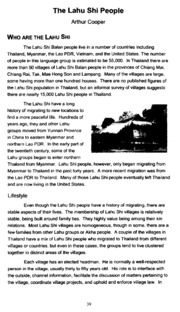Table Of ContentThe Lahu Shi People
Arthur Cooper
Who are the Lahu Shi
The Lahu Shi Balan people live in a number ofcountries including
Thailand. Myanmar, the Lao PDR. Vietnam, and the United States, The number
of people inthis language group is estimated to be 55,000, In Thailand thereare
morethan 50 villages ofLahu Shi Balan people in the provinces ofChiang Mai.
Chiang Rai. Tak, Mae Hong Son and Lampang. Many ofthevillages are large,
some having more than one hundred houses. Thereare no published figures of
the Lahu Shi population in Thailand, but an informal surveyofvillages suggests
there are nearly 15.000 Lahu Shi people in Thailand.
The Lahu Shi have a long
historyof migrating to newlocationsto
find a more peaceful life. Hundreds of
years ago, they and other Lahu
groups moved from Yunnan Province
in China to eastern Myanmar and
northern Lao PDR. In the early part of
the twentieth century, some ofthe
Lahu groups t)egan to enternorthern
Thailand from Myanmar. Lahu Shi people, however, only began migrating from
MyanmartoThailand in the pastforty years. A more recent migration wasfrom
the Lao PDR to Thailand. Manyofthose Lahu Shi people eventuallyleftThailand
and are nowliving in the United States.
Lifestyle
Even though the Lahu Shi people have a historyofmigrating, there are
stable aspects oftheirlives. The memt>ershipofLahu Shi villages is relatively
stable, being built around familyties. They highlyvalue being among their kin
relations. Most Lahu Shi villages are homogeneous, though in some, there are a
fewfamiliesfrom otherLahu groupsorAkha people. Acouple of the villages in
Thailand havea mix ofLahu Shi people who migrated toThailand from different
villages orcountries, buteven in these cases, the groups tend to liveclustered
together in distinctareas ofthe villages.
Each village has an elected headman. He is normallya well-respected
person in the village, usuallythirtytofrfty years old. His role is to interface with
the outside, channel information, facilitate the discussion ofmatters pertaining to
the village, coordinate village projects, and uphold and enforcevillage law. In
39
Cooper- Lahu Shi Orthorgaphy 40
Thailand, thistraditional roie is replaced bythe correspondingThaigoverning
system. This gives the headman the additional responsibilityofreportingtothe
local govemment, which requires having someeducation intheThai system.
Each village has a village council thatworks with and assists theheadman.
In addition to a headman, the Lahu Shi
traditionallyhave a religious authorityfigure in
theirvillage leadership structure. Thetraditional
Lahu beliefsystem is a combinationofanimism
over a nearly monotheistic base. The religious
authorityfigure is usuallya man and could be
called a priestorshaman. He and the headman
have similarlevels ofauthority in the village,
though the shaman does notgenerallydeal with
civicfunctions like the headman. This person
dealswith religious issues and traditk>nal
medicine. In Thailand and Myanmar, mostofthe
Lahu Shi adopted Christianity, and the church
chairman orvillage pastorfills the religious leaderrole. Although theyare not
officially part ofthe village leadership structure, they seem to exercise
considerable authority in many activities in the community.
Living
The hills and forests surrounding a Lahu Shivillagearetheeconomic
centerfor mostofthe needs ofthe community. As subsistencefarmers,
husbands and wives usuallywork theirfields togethercultivating drypaddyrice,
corn and vegetables fortheirfamily's consumption. In Thailand, some people
raise cashcrops such as gingerorvariousfruits, Ghk:kens, pigs, and cows are
the majorsources ofmeatand aresometimes sold forcash. Waterbuffalo are
sometimes used forwork in fields suitableforwetricecultivation. Mountain
ponies are often used to bear burdensfrom the faroffhillside fields. Anumberof
forest products aregathered forpersonal use as well as forsale outsidethe
community.
Buying and selling in lo^and markettowns t>rings resources to the
village and is an outletfortheir products and services. Thevillage blacksmith
often makes the tools and implements neededforfarming and hunting, butthe
metal forthem is purchased from outsiders. Womenweaveon back-strap looms
and sew tx)th for their own needsaswelt asfor sale in shops and markets. In the
past, the thread and cloth used in this home industrywas made inthe village, but
nowtheypurchasethese supplies in marketcenters. Some men and women
leave theirvillages for brieftimes towork as laborers in construction in urtian
centers, orplantand harvest rice and othercrops forlowlandfarmers.
Cooper-Lahu S\\\Orthorgaphy ^^
Avery importantreason for Lahu Shi peopleto go outside oftheir
communityisforeducation. Mostoftheir villages in Thailand have schools with
grades of>ethroughsix. Many Lahu Shivillages have established and run pre-
schoolsto teach their children somelt>9sic Thai before theystart school. The
Lahu Shi highlyvalue education andparentstryto provide opportunities for their
children to pursue education in urban centers. Some peoplewho receive
advanced education do not return totheir home villages, butinstead stayin the
larger urt>an centerswhere theyspentyears in schools. These people often
believethere are betteroptionsforthem there, butthey alsousually maintain
strong tieswithfamily in theirhomevillages.
i,ua4iwjvnjj^fia'3l^msjfiii?'3W?syv\i?2:ifiW4Viii9M'i 6 fan
In Honor of
His Majesty King Bhumibol Adulyadej
On theAuspicious Occasion of his Sixth Cycle Birthday
Minority Language Orthograph in Thailand;
Five Case Studies
Edited by the TU-SIL-LRDP Committee
Under the auspices ofThammasat University
and in cooperation with SIL International
January2002

